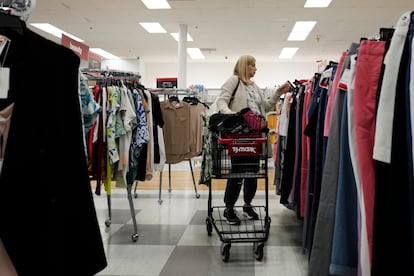US consumer inflation eased slightly last month as gas prices fell, though some costs kept surging
Prices in some areas — services such as rents, restaurants and auto insurance — continued to rise uncomfortably fast

U.S. inflation ticked down again last month, with cheaper gas helping further lighten the weight of consumer price increases in the United States.
At the same time, the latest data on consumer inflation showed that prices in some areas — services such as rents, restaurants and auto insurance — continued to rise uncomfortably fast.
Tuesday’s report from the Labor Department said the consumer price index rose just 0.1% from October to November. Compared with a year earlier, prices were up 3.1% in November, down from a 3.2% year-over-year rise in October.
But core prices, which exclude volatile food and energy costs, rose 0.3% from October to November, slightly faster than the 0.2% increase the previous month. Measured from a year ago, core prices rose 4%, the same as in October. The Federal Reserve considers core prices to be a better guide to the future path of inflation.
The stickiness of inflation in the economy’s service sector will likely keep the Federal Reserve on guard as it meets this week. Fed Chair Jerome Powell has been scrutinizing such costs as a guide to whether underlying inflationary trends are cooling.
Services prices for such items as hotels, health care and entertainment are heavily determined by wages because they are labor-intensive. And wages are still rising rapidly, though they’ve eased from pandemic-era peaks.
Restaurant prices are an example. They rose 0.4% from October to November for a third straight month, leaving them 5.3% more expensive than they were a year earlier. Rents are also fueling inflation: They accelerated from October to November. (Real-time data from companies like Zillow and ApartmentList, though, suggest that apartment rent growth is slowing.)
Gas prices tumbled 6% just from October to November. From a peak of $5 about a year and a half ago, the national average has dropped to $3.15 a gallon as of Monday, according to AAA.
And grocery prices ticked up just 0.1% in November and are only 1.7% higher than they were a year ago. Bread, beef, chicken and pork prices all dropped.
Many goods prices, including furniture, clothing and appliances, fell last month. Used cars were an exception. Their average prices jumped 1.6% in November, though they’re still down nearly 4% from 12 months earlier.
The mixed picture in Tuesday’s inflation report will likely keep the Fed on track to leave its benchmark interest rate unchanged when its latest meeting ends Wednesday. Inflation still exceeds the Fed’s 2% annual target, which is why its officials are set to leave rates high. But with inflation cooling faster than expected, the Fed’s policymakers likely see no cause to further raise rates, at least for now.
The Fed’s widely expected decision to keep its key rate unchanged for a third straight time suggests that it’s probably done raising borrowing costs. The central bank has raised its key rate to about 5.4%, the highest level in 22 years, in a determined drive to conquer inflation. Its rate hikes have made mortgages, auto loans, business borrowing and other forms of credit much costlier, reflecting the Fed’s goal of slowing borrowing and spending enough to tame inflation.
Even if the central bank is done raising rates, it’s expected to keep its benchmark rate at a peak for at least several more months. Powell has even warned that the Fed might decide to raise rates again if it deems it necessary to defeat high inflation. The Fed raised its key short-term rate 11 times starting in March 2022.
According to a lesser-known inflation gauge that the Fed prefers, core prices rose 3.5% in October compared with 12 months earlier. That was less than the central bank’s forecast of 3.7% for the final three months of this year.
Inflation’s steady decline has sparked speculation about interest rate cuts next year, with some economists floating the potential for cuts as early as March. The Fed’s preferred inflation gauge has increased at an annual pace of just 2.5% in the past six months.
But Powell has so far brushed aside the idea that the Fed might cut rates anytime soon. He is expected to say so again Wednesday.
“It would be premature,” Powell said earlier this month, “to speculate” on the possibility of Fed rate cuts.
Sign up for our weekly newsletter to get more English-language news coverage from EL PAÍS USA Edition
Tu suscripción se está usando en otro dispositivo
¿Quieres añadir otro usuario a tu suscripción?
Si continúas leyendo en este dispositivo, no se podrá leer en el otro.
FlechaTu suscripción se está usando en otro dispositivo y solo puedes acceder a EL PAÍS desde un dispositivo a la vez.
Si quieres compartir tu cuenta, cambia tu suscripción a la modalidad Premium, así podrás añadir otro usuario. Cada uno accederá con su propia cuenta de email, lo que os permitirá personalizar vuestra experiencia en EL PAÍS.
¿Tienes una suscripción de empresa? Accede aquí para contratar más cuentas.
En el caso de no saber quién está usando tu cuenta, te recomendamos cambiar tu contraseña aquí.
Si decides continuar compartiendo tu cuenta, este mensaje se mostrará en tu dispositivo y en el de la otra persona que está usando tu cuenta de forma indefinida, afectando a tu experiencia de lectura. Puedes consultar aquí los términos y condiciones de la suscripción digital.
More information
Archived In
Últimas noticias
Most viewed
- Sinaloa Cartel war is taking its toll on Los Chapitos
- Oona Chaplin: ‘I told James Cameron that I was living in a treehouse and starting a permaculture project with a friend’
- Reinhard Genzel, Nobel laureate in physics: ‘One-minute videos will never give you the truth’
- Why the price of coffee has skyrocketed: from Brazilian plantations to specialty coffee houses
- Silver prices are going crazy: This is what’s fueling the rally










































